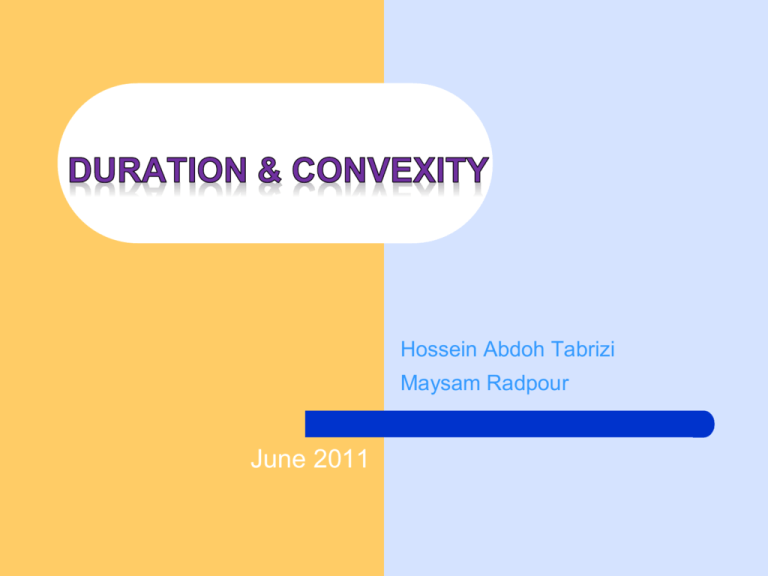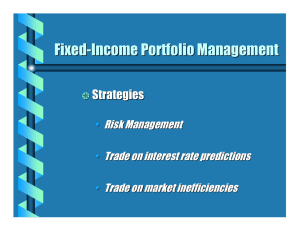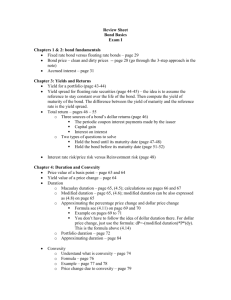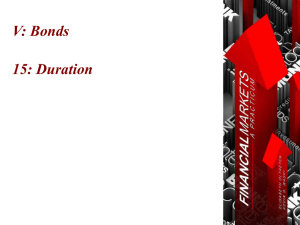Duration & Convexity
advertisement

Hossein Abdoh Tabrizi Maysam Radpour June 2011 Table of Contents • Bonds; risk & return tradeoff • Maturity effect; interest rate volatility risk • Duration • Convexity Bonds Risk & return tradeoff Types of bonds based on option granted to the issuer or bondholder Without option Optionfree bonds Option for issuer Callable bonds Option for bondholder Putable bonds Factors effect bond return Risks of return Does the issuer do it’s obligations? • Default risk How much is the interest rate volatile? • Interest rate volatility risk What is the rate of periodical payments return? • Reinvestment risk Is there an active secondary market? • Liquidity risk Maturity Effects Interest rate volatility risk Price volatility in option-free bonds There is a reverse relationship Price between yield to maturity and price . Yield to maturity Factors affecting interest rate volatility Coupon rate • All other factors maturity Yield to maturity • All other factors • All other factors constant, the lower constant, the constant, the the coupon rate, longer the maturity, higher the yield the greater the the greater the level, the lower the price volatility. price volatility. price volatility. Percentage price change for Four Hypothetical Bonds Initial yield for all four bonds is 6% Percentage price change New yield 6% 5-year 6% 20-year 9% 5-year 9% 20-year 4.00% 5.00% 5.50% 5.90% 5.99% 6.01% 6.10% 6.50% 7.00% 8.00% 8.98 4.38 2.16 0.43 0.04 -0.04 -0.43 -2.11 -4.16 8.11 27.36 12.55 6.02 1.17 0.12 -0.12 -1.15 -5.55 -10.68 -19.79 8.57 4.17 2.06 0.41 0.04 -0.04 -0.41 -2.01 -3.97 -7.75 25.04 11.53 5.54 1.07 0.11 -0.11 -1.06 -5.13 -9.89 -18.40 Duration Duration is a measure of interest rate volatility risk: • Duration is the measure of fixed income securities price sensitivity versus interest rate changes. • Duration encompasses the three factors (coupon, maturity and yield level) that affects bond’s price volatility. Duration Duration is a proxy for maturity: • Duration is a proxy better than maturity and may be considered as effective maturity of fixed income securities. • Duration is standardized weighted average of bond’s term to maturity where the weights are the present value of the cash flows. Duration is elasticity dP P P P Modified duration dy y Price equation of an option-free bond C C CM P 1 2 (1 y) (1 y) (1 y) n P: price C: periodical coupon interest Y: yield to maturity M: maturity value (face value) N: number of periods First derivative of price equation The first derivative of price equation shows the approximate change in price when small change in yield occurs. dP 1 1C 2C n (C M ) 1 2 n dy (1 y) (1 y) (1 y) (1 y) Macaulay duration, Modified duration dP 1 1 1 1C 2C n (C M ) dy P (1 y) P (1 y)1 (1 y) 2 (1 y) n Macaulayduration 1 1C 2C n (C M ) P (1 y)1 (1 y) 2 (1 y) n Modified duration 1 1 1C 2C n (C M) (1 y) P (1 y)1 (1 y) 2 (1 y) n Example 1: Duration calculation Duration for a 9% 5-year bond selling to yield 6% with semiannual coupon payments and face value of 100$ is: Period 1 2 3 4 5 6 7 8 9 10 Cash flow Present value PV× t 4.5 4.5 4.5 4.5 4.5 4.5 4.5 4.5 4.5 104.5 4.3689 4.2417 4.1181 3.9982 3.8817 3.7687 3.6589 3.5523 3.4489 77.7578 112.7953 4.3689 8.4834 12.3544 15.9928 19.4087 22.6121 25.6124 28.4187 31.0399 777.5781 945.8694 Total Macaulay duration (in half years) 8.38 Macaulay duration (in years) 4.19 Modified duration (in years) 4.07 Example 2: Using duration to approximate price change Macaulay duration 10.98 10.98 Modified duration 10.66 (1 0.03) dP P Modified duration Modified duration y P P P 10.66 (0.001) 1.066 % P P 10.66 (0.001) 1.066 % P When duration does not work well? Example 3: When duration does not work well? For the previous example, the real and approximate price change when yields change are as follows: Yield change (in percent) 0.1 -0.1 2.0 -2.0 Real price change (based on price equation) Approximate price change (based on duration) difference -1.60 +1.70 -18.40 +25.04 -1.66 +1.66 -21.32 +221.32 0.06 0.04 2.92 3.72 Reason of duration inadequacy Price Underestimation Overestimation y2 y y1 Yield Improvement in price change approximation dP 1 d2P 1 dP dy dy Error 2 dy 2 dy P dP dP 1 1 d 2P 1 Error 2 dy (dy ) 2 P dy P 2 dy P P Convexity calculation 1 d2 1 Convexity 2 dy 2 P 1 1 1 1 2C 2 3C n (n 1)(C M ) Convexity 2 (1 y) 2 P (1 y)1 (1 y) 2 (1 y) n Example 4: convexity calculation Convexity for a 9% 5-year bond selling to yield 6% with semiannual coupon payments and face value of 100$ is: Period 1 2 3 4 5 6 7 8 9 10 Total Cash flow PV PV × t × (t+1) 4.5 4.3689 4.2417 4.1181 3.9982 3.8817 3.7687 3.6589 3.5523 8.7378 25.4502 49.4172 79.964 116.451 158.2854 204.8984 255.7656 3.4489 77.7578 310.401 8553.358 112.7953 9762.729 4.5 4.5 4.5 4.5 4.5 4.5 4.5 4.5 104.5 Convexity (in half years ) 40.792 Convexity (in years) 10.198 Example 5: Using convexity to approximate price change Convexity 82.053 P (Convexity ) (y) 2 82.053 (0.02) 2 3.28% P P (Convexity ) (y) 2 82.053 (0.02) 2 3.28% P Using duration and convexity simultaneously MD (y) C (y) 2 Example 6: Comparing approximate price change using duration and convexity and real price change Yield change (in percent) Real price change (based on price equation) Approximate price change (based on convexity) difference 2 -18.40 -18.04 -0.36 -2 +25.04 +24.60 0.44 THANKS







